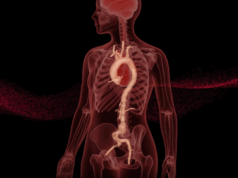
In a session focused on new technologies at this year’s London Aorta meeting (10–11 October, London, UK), Celia Riga discussed the rise of robotics, artificial intelligence (AI), and wearables, informing delegates about the “merits and responsibilities” of being either an innovator, early adopter, or consumer of these new technologies.
The Royal College of Surgeons recently published the Commission on the Future of Surgery identifying which technologies will make the greatest impact in years to come. Technologies such as Robotics, AI and wearables feature heavily and are all in use today. This leaves us, the clinical teams, with three options: becoming innovators, early adopters or consumers. Each option comes with different merits and responsibilities. For cardiovascular medicine, robotic applications involve either laparoscopic systems such as the Da Vinci robot, or endovascular catheter platforms such as the Corpath system from Corindus or the more electromechanically advanced Magellan robot, from Hansen Medical/Auris that was recently acquired by Johnson & Johnson for US$3.4 billion.
Health technology assessment (HTA) to evaluate safety, feasibility and efficiency constitutes an essential pre-requisite for all novel technologies. For robotic catheter technology utilising the Magellan co-axial catheter platform, the HTA process at Imperial College London over the last decade is a good example of translational bench-to-bedside research, involving proof of concept, a rigorous pre-clinical evaluation programme, first-in-man, subsequent collaboration with industry for FDA approval and CE marking, in-house engineering input through the Hamlyn Centre for Robotic Surgery and a graduated clinical evaluation programme. We have treated 116 patients at Imperial College Healthcare NHS Trust, with 150 intervention targets and excellent technical success through a range of interventions: standard and complex endovascular aneurysm repair, occlusive disease, arch and carotid intervention, occlusive disease and complex endoleak treatments. There was no mortality, no adverse neurology and no access/device path complications relating to robotic use. Although the data is heterogenous, involving multiple vascular beds, the most important message from this series and our early clinical experience is that 16% of these cases had previously failed with manual approaches and a 42% of the total cohort were selected due to adverse anatomy. We as well as others have demonstrated safety and feasibility for robotic endovascular technology, yet the greatest benefit is seen in the more complex endovascular tasks. When compared with manual manipulation there appears to be less unnecessary movements and contact with the vessel wall, less HITS on TCD evaluation, shorter path-lengths from access to target and reduced variability in performance even in the hands of highly experienced operators. Radiation exposure for operators is significantly reduced as the workstation is located away from the X-ray source. The stability of the robotic sheath obviates the need for axillary access. Even when manual input is required, robotic sheath stability facilitates the necessary exchanges reducing radiation further especially for high-risk procedural stages such as visceral interventions. Learning curves are short: for experienced operators, performance is enhanced. Less experienced operators reach the appropriate level of competence earlier and with a greater degree of safety. Current commercial robotic catheter systems do not have integrated localisation capabilities. They do however provide the ideal platform for integrating sensing and intelligent imaging technologies in a move towards X-ray-free intervention, and that is our current focus at Imperial’s Hamlyn centre supported by an EPSRC multi-million-pound investment.
Patients seem to embrace novel technologies yet adoption is slow. Barriers to adoption include culture, implementation and training challenges, and predominantly cost. Lack of high-level evidence also hinders more widespread use. Generation of high-level evidence, however, requires time but the dynamic nature of medical robotics is not compatible with level-1 or randomized trials to generate level-1 evidence and inform on long-term efficacy. Another important constraint is when the primary diffusion driver moves from R&D to marketing as it restricts continuing enhancement of novel technologies based on clinical feedback, once they have reached the market. The Royal College of Surgeons, more recently published guidance on implementation of new technologies and techniques stressing the importance of innovation yet highlighting the importance of team training, patient selection, consent, managing conflict of interest, and outcomes monitoring through well-structured registries and databases. It also emphasizes the need for financial incentives to clinical translation and “scaling-up” such as the “Innovation and Technology Tariff”.
The medical robotics market is expected to reach $22.billion by 2027 and the NHS has already seeded £50 million towards a robotic framework. Robotic catheter technology is somewhat limited to procedural stage yet it is safe and feasible and particularly valuable for complex tasks such as FEVAR, manipulation in the arch and complex embolisations. There is great potential for radiation reduction for patients and staff. In an era where there is a pressing need to improve the durability and cost-effectiveness of endovascular intervention, robotics will play a key role through endosuturing, sensing, image guidance, materials, manufacturing and surveillance strategies.
Celia Riga is a consultant vascular surgeon and senior lecturer at Imperial College London, UK. She is the Vascular Training Programme director for the London region.













